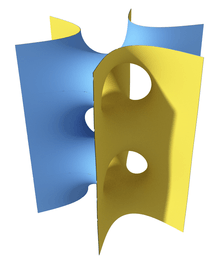K-noid


In differential geometry, a k-noid is a minimal surface with k catenoid openings. In particular, the 3-noid is often called trinoid. The first k-noid minimal surfaces were described by Jorge and Meeks in 1983.[1]
The term k-noid and trinoid is also sometimes used for constant mean curvature surfaces, especially branched versions of the unduloid ("triunduloids").[2]
k-noids are topologically equivalent to k-punctured spheres (spheres with k points removed). k-noids with symmetric openings can be generated using the Weierstrass–Enneper parameterization  .[3] This produces the explicit formula
.[3] This produces the explicit formula
where  is the Gaussian hypergeometric function.
is the Gaussian hypergeometric function.
It is also possible to create k-noids with openings in different directions and sizes,[4] k-noids corresponding to the platonic solids and k-noids with handles.[5]
References
- ↑ L. P. Jorge and W. H. Meeks III, The topology of complete minimal surfaces of finite total Gaussian curvature, Topology 22 (1983)
- ↑ N Schmitt. "Constant Mean Curvature n-noids with Platonic Symmetries". Arxiv.org. Retrieved 2012-10-05.
- ↑ Matthias Weber (2001). "Classical Minimal Surfaces in Euclidean Space by Examples". Indiana.edu. Retrieved 2012-10-05.
- ↑ H. Karcher. "Construction of minimal surfaces, in "Surveys in Geometry", University of Tokyo, 1989, and Lecture Notes No. 12, SFB 256, Bonn, 1989, pp. 1-96". Math.uni-bonn-de. Retrieved 2012-10-05.
- ↑ Jorgen Berglund, Wayne Rossman. "Minimal Surfaces with Catenoid Ends. Pacific J. Math. Volume 171, Number 2 (1995),pp. 353-371". Arxiv.org. Retrieved 2012-10-05.
External links
| ||||||||
![\begin{align}
X(z) = \frac{1}{2} \Re \Bigg\{ \Big(\frac{-1}{kz(z^k-1)} \Big) \Big[ &(k-1)(z^k-1)_2F_1(1,-1/k;(k-1)/k;z^k)\\
& {}-(k-1)z^2(z^k-1)_2F_1(1,1/k;1+1/k;z^k) \\
&{}-kz^k +k+z^2-1 \Big] \Bigg\}
\end{align}](../I/m/8a8a9f92344bc5d5d29984f1743c9a0a.png)
![\begin{align}
Y(z) = \frac{1}{2} \Re \Bigg\{ \Big(\frac{i}{kz(z^k-1)}\Big) \Big[ &(k-1)(z^k-1)_2F_1(1,-1/k;(k-1)/k;z^k) \\
&{}+(k-1)z^2(z^k-1)_2F_1(1,1/k;1+1/k;z^k)\\
& {}-kz^k+k-z^2-1 ) \Big] \Bigg\}
\end{align}](../I/m/d12a65a003516400ac8d2387e4dc4e95.png)

